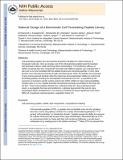Rational Design of a Biomimetic Cell Penetrating Peptide Library
Author(s)
Urbanska, Aleksandra M.; Sahay, Gaurav; Jhunjhunwala, Siddharth; Karagiannis, Emmanouil; Anderson, Daniel Griffith; Pelet, Jeisa; Langer, Robert S; ... Show more Show less
DownloadLanter_Rational design.pdf (2.668Mb)
PUBLISHER_POLICY
Publisher Policy
Article is made available in accordance with the publisher's policy and may be subject to US copyright law. Please refer to the publisher's site for terms of use.
Terms of use
Metadata
Show full item recordAbstract
Cell penetrating peptides have demonstrated potential to facilitate the cellular delivery of therapeutic molecules. Here we develop a set of 50 cell penetrating peptide based formulations with potential to deliver small interfering RNAs intercellularly. The transfection efficacy of siRNA containing lipid-like nanoparticles decorated with different peptides was evaluated both in vitro and in vivo and correlated with the peptide physical and chemical properties. In vitro, these particles were internalized primarily through macropinocytosis. When the peptides were presented to bone marrow-derived dendritic cells, they induce low immunoactivation relative to control cell penetrating peptides including the antennapedia homeodomain and TAT, as quantified by the expression of activation specific surface proteins like CD80, CD86, and major histocompatibility complex class II. In vivo, peptide decorated nanoparticles primarily accumulated in the lungs and the liver. Three human peptides derived from surfactant protein B (a lung surfactant protein), orexin (a neuropeptide hormone, and lactoferricin (a globular glycoprotein) that exist in many physiological fluids facilitated the in vivo delivery of siRNA and induce significant knock down (90%) of a hepatocyte expressed protein, coagulation Factor VII.
Date issued
2013-09Department
Harvard University--MIT Division of Health Sciences and Technology; Massachusetts Institute of Technology. Department of Chemical Engineering; Massachusetts Institute of Technology. Media Laboratory; Koch Institute for Integrative Cancer Research at MITJournal
ACS Nano
Publisher
American Chemical Society (ACS)
Citation
Karagiannis, Emmanouil D., Aleksandra M. Urbanska, Gaurav Sahay, Jeisa M. Pelet, Siddharth Jhunjhunwala, Robert Langer, and Daniel G. Anderson. “Rational Design of a Biomimetic Cell Penetrating Peptide Library.” ACS Nano 7, no. 10 (October 22, 2013): 8616–8626.
Version: Author's final manuscript
ISSN
1936-0851
1936-086X